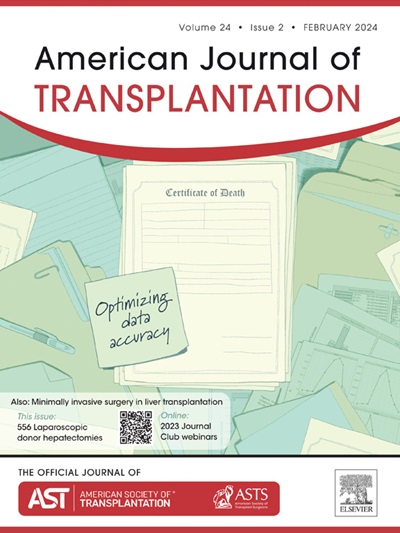Molecular diagnosis of kidney allograft rejection based on the Banff Human Organ Transplant gene panel: A multicenter international study
IF 8.2
2区 医学
Q1 SURGERY
引用次数: 0
Abstract
Transcriptomic analysis of kidney biopsies has demonstrated the potential to improve diagnosis of allograft rejection. Here, we developed a molecular assessment of antibody-mediated rejection (AMR) and T cell–mediated rejection (TCMR) based on the Banff Human Organ Transplant consensus gene panel. Expression assays of formalin-fixed paraffin-embedded kidney biopsies from well-phenotyped cohorts were used to develop prediction models for AMR and TCMR and an automated report of gene expression-based diagnosis. The study population consisted of 950 kidney allograft biopsies from 10 transplantation centers in Europe and North America. The development cohort included 664 renal allograft biopsies split into a training (n = 537) and test set (n = 127), and 2 external validation cohorts (n = 286). We performed gene selection using regularized regression and developed several different base models based on Banff Human Organ Transplant expression data, which were combined into a single ensemble model for each rejection diagnosis. Model performance was assessed in the test set and the 2 external validation cohorts, showing good discriminative abilities (respective areas under the precision-recall curve: AMR = 0.811, 0.891, and 0.832 and TCMR = 0.736, 0.810, and 0.782). We identified challenging biopsies with histology below diagnostic thresholds for which gene expression-based probability can refine rejection diagnosis. This automated molecular diagnostic system shows potential for improving kidney allograft rejection diagnosis in routine practice and clinical trials.
基于班夫人类器官移植(B-HOT)基因面板的肾移植排斥反应分子诊断:一项多中心国际研究
肾活检的转录组学分析已经证明有潜力改善同种异体移植排斥反应的诊断。在这里,我们基于Banff-Human-Organ-Transplant (B-HOT)共识基因面板开发了抗体介导的排斥反应(AMR)和t细胞介导的排斥反应(TCMR)的分子评估。来自表型良好队列的福尔马林固定石蜡包埋肾活检组织的表达测定用于建立AMR和TCMR的预测模型,以及基于基因表达的自动诊断报告。研究人群包括来自欧洲和北美10个移植中心的950例肾移植活检。发展队列包括664例肾移植活检,分为训练组(n=537)和测试组(n=127),以及两个外部验证队列(n=286)。我们使用正则化回归进行基因选择,并基于B-HOT表达数据建立了几个不同的基础模型,并将其合并为每个排斥诊断的单个集合模型。在测试集和两个外部验证队列中评估模型性能,显示出良好的判别能力(PR-AUC AMR=0.811, 0.891, 0.832, TCMR=0.736, 0.810, 0.782)。我们确定了组织学低于诊断阈值的挑战性活组织检查,其中基于基因表达的概率可以改进排斥诊断。这种自动分子诊断系统在常规实践和临床试验中显示出改善同种异体肾移植排斥诊断的潜力。
本文章由计算机程序翻译,如有差异,请以英文原文为准。
求助全文
约1分钟内获得全文
求助全文
来源期刊
CiteScore
18.70
自引率
4.50%
发文量
346
审稿时长
26 days
期刊介绍:
The American Journal of Transplantation is a leading journal in the field of transplantation. It serves as a forum for debate and reassessment, an agent of change, and a major platform for promoting understanding, improving results, and advancing science. Published monthly, it provides an essential resource for researchers and clinicians worldwide.
The journal publishes original articles, case reports, invited reviews, letters to the editor, critical reviews, news features, consensus documents, and guidelines over 12 issues a year. It covers all major subject areas in transplantation, including thoracic (heart, lung), abdominal (kidney, liver, pancreas, islets), tissue and stem cell transplantation, organ and tissue donation and preservation, tissue injury, repair, inflammation, and aging, histocompatibility, drugs and pharmacology, graft survival, and prevention of graft dysfunction and failure. It also explores ethical and social issues in the field.

 求助内容:
求助内容: 应助结果提醒方式:
应助结果提醒方式:


